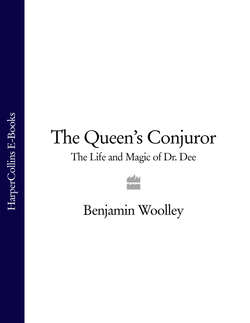Читать книгу The Queen’s Conjuror: The Life and Magic of Dr. Dee - Benjamin Woolley - Страница 7
INTRODUCTION
ОглавлениеOne day in 1642, Robert Jones, a confectioner living at the sign of the Plough in London’s Lombard Street, decided to go with his wife Susannah to Addle Street, a lane running up from Casde Baynard, the great Norman fort on the banks of the Thames.1 The street was lined with joiners’ shops, and Mr and Mrs Jones were out to buy some ‘household stuff’. Their eyes alighted on a ‘Chest of Cedar wood, about a yard & a half long’. The lock and hinges were of such ‘extraordinary neat work’, the chest ‘invited them to buy it.’
They discovered from the shopkeeper that the chest had come from the household of Thomas Woodall, a royal surgeon.2 Woodall had apparently inherited it from his father, who was also a surgeon. Mr and Mrs Jones bought it and took it back to Lombard Street, where it remained undisturbed for twenty years.
In 1662, they decided to move the chest. When they lifted it, they heard a rattle ‘toward the right hand end, under the Box or Till thereof, & by shaking it, were fully satisfied it was so.’ Mr Jones decided to investigate further. In the base of the box, he discovered a ‘small crevice’ or slit. He stuck a knife into it, and a hidden drawer popped out. Inside he found a collection of books, papers and a small casket containing a necklace of beads made of olive stones, from which dangled a wooden cross.
The Joneses leafed through the books and papers but could make no sense of them. They had Latin titles such as 48 Claves Angclicae (The 48 Angelic Keys), and contained gibberish, word squares, hieroglyphs and tables. They put the pile to one side.
When their maid found the papers, she thought them particularly suitable for the lining of pie tins and ‘other like uses’. She had worked her way through about half the pile before her employers noticed. They put the surviving documents back in the chest, and forgot about them once more.
Mr Jones died in 1664. Two years later, the Great Fire of London broke out. As panic spread through the surrounding streets, Susannah Jones gathered together as many possessions as she could carry and took them to safety in Moorfields, north of the City wall. Too heavy to move, the chest was left to burn along with her home. However, she decided to remove the mysterious papers from the hidden drawer and take them with her.
Soon after, she remarried. Her new husband was Thomas Wale, a warder at the Tower of London. She showed him the papers, and, though he could make no sense of them either, he recognised their potential value. He knew of a man with an interest in such works, a lawyer and collector called Elias Ashmole.
Ashmole was an expert in astrology, alchemy and other occult matters. He was also one of the most important antiquarians of the seventeenth century, his collection forming the basis for Oxford’s magnificent Ashmolean Museum. On 20 August 1672, while he was at the country house of his friend the astrologer William Lilly in Hersham, Surrey, his servant Samuel Story turned up with a parcel containing the preserved papers. Thomas Wale wondered if Ashmole would be prepared to swap them for a volume on the Order of the Garter.
When Ashmole unwrapped the parcel, he could barely contain his excitement. These were papers he had spent years searching for, and had assumed to be destroyed. He arranged to meet Mr Wale’s wife a week later at the Excise Office in Broad Street, where he worked. When she told him the story of how the papers had come into her possession, his hopes were confirmed. John Woodall, the father of the former owner of the chest, had been one of the last known custodians of the effects of Dr John Dee.3 These volumes were the surviving remnants of Dee’s Liber Mysteriorum, his book of mysteries. According to the man in whose hand they were written, they contained the secrets of the universe.
